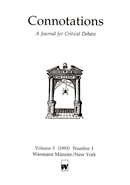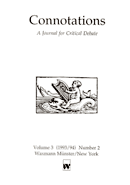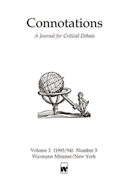Connotations Vol.3
(1993/94)
Articles in this issue
- The House of Fame: Tripartite Structure and Occasion
John M. Steadman, 3.1:1-12. - A Collection of Toothpicks from The Winter's Tale to Leviathan1)
Robert G. Collmer, 3.1:13-25. - Connotations of "Strange Meeting"
Kenneth Muir, 3.1:23-36. - A Reply to Mary Carruthers, "Inventional Mnemonics and the Ornaments of Style"
Lina Bolzoni, 3.1:37-41. - Some Notes on William Harmon, "Paronomastics"
A. R. Ammons, 3.1:42-43. - A Response to William Harmon
W. F. H. Nicolaisen, 3.1:44-47. - Words, Weapons, and Role-players: A Reply to Stanley Hussey
Robert Crosman, 3.1:48-51. - Generalization Must Be, but Woe unto the Generalizer: A Reply to Jonas Barish
Robert Crosman, 3.1:52-55. - Hamlet and After
Holger Klein, 3.1:56-59. - "Double Nature's Single Name": A Response to Christiane Gillham
Peter Milward, 3.1:60-63. - Shakespeare's "The Phoenix and the Turtle": A Reconsideration of "Single Natures Double Name"
James H. Sims, 3.1:64-71. - "Mind the Gap": A Comment on Lothar Černý
Brean S. Hammond, 3.1:72-78. - Fielding and the "Sagacious Reader": A Response to Lothar Černý
Nicholas Hudson, 3.1:79-84. - Fielding, Reception Theory and Rationalism: A Reply to Brean Hammond and Nicholas Hudson
Lothar Černý, 3.1:85-89. - Palm Reading (A Response to Eleanor Cook)
Timothy Bahti, 3.1:90-94. - A Note on Eleanor Cook, "From Etymology to Paronomasia"
John Hollander, 3.1:95-98. - Paronomasia Once More
Eleanor Cook - Paronomasia Once More, 3.1:98-102. - Inventional Mnemonics, Reading and Prayer: A Reply to Mary Carruthers
Sylvia Huot, 3.2:103-09. - The House of Fame: Tripartite Structure and Occasion
R. J. Schoeck, 3.2:110-14. - A Response to Judith Dundas, "Paronomasia in the Quip Modest"
Debra Fried, 3.2:115-25. - Half a Miracle: A Response to William Harmon
Paul J. C. M. Franssen, 3.2:118-22. - Single Natures Double Name: A Reply to Peter Milward and James H. Sims
Christiane Gillham, 3.2:123-28. - Notations on Connotations 3.1
Peter Milward, 3.2:129-32. - Brightness and Beauty, Taste and Relish: Advertising and Vindicating Eighteenth-Century Novels2)
Andrew Varney, 3.2:133-49. - Gaps and Stumbling-Blocks in Fielding: A Response to Černý, Hammond and Hudson
Bernard Harrison, 3.2:147-72. - "Strange Meeting" Again
Douglas Kerr, 3.2:173-85. - "Strange Meeting," a Fragment? A Reply to Muir's "Owen"
Jon Silkin, 3.2:186-92. - Christmas as Humbug: A Manuscript Poem by Letitia Elizabeth Landon ("L. E. L.")
F. J. Sypher, 3.2:193-203. - Notes from the Body
Jacqueline Vaught Brogan, 3.2:204-06. - A Note on 'Notes from the Body'
Alicia Ostriker, 3.2:207-08. - Reading Jacqueline Vaught Brogan's "Notes from the Body"
Martine Watson Brownley, 3.2:209-12. - Reason in English Renaissance Humanism: Starkey, More, and Ascham
Åke Bergvall, 3.3:213-25. - Shakespearean Tragedy: Its Christian Premises
Roy Battenhouse, 3.3:226-42. - Was The Raigne of King Edward III a Compliment to Lord Hunsdon?
Roger Prior, 3.3:243-64. - Faulkner and Racism
Arthur F. Kinney, 3.3:265-78. - Antidrama—Metadrama—Artistic Program? Arthur Kopit's The Hero in Context
Bernd Engler, 3.3:279-90. - Chivalry and Courtesy: A Comment on Richard McCoy, The Rites of Knighthood
Thomas Kullmann, 3.3:292-302. - Shakespeare, Burgess, and Psalm 46: A Note in Reply to Paul Franssen
William Harmon, 3.3:303-04. - Romance and the Didactic in the Eighteenth-Century Novel: An Elaboration upon Andrew Varney
Brean S. Hammond, 3.3:305-11. - "But the poet ... never affirmeth": A Reply to Bernard Harrison
Lothar Černý, 3.3:312-17. - "Strange Meeting" Yet Again
Kenneth Muir, 3.3:318-20.


